人教版英语九年级全一册教案Unit13 SectionA1a 2d
- 格式:doc
- 大小:23.46 KB
- 文档页数:4
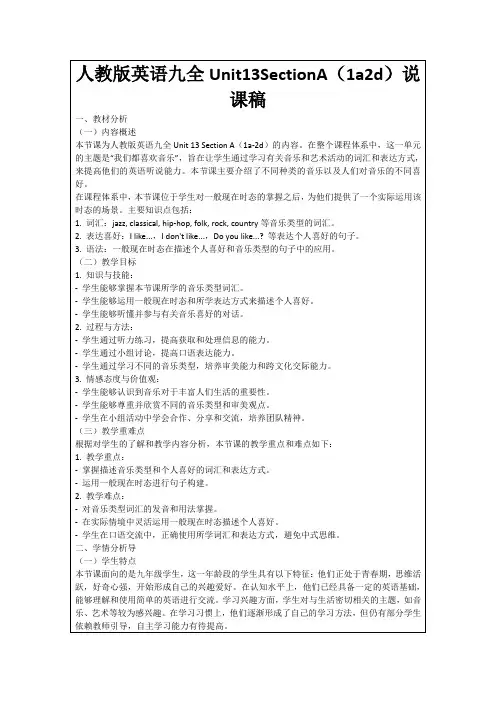
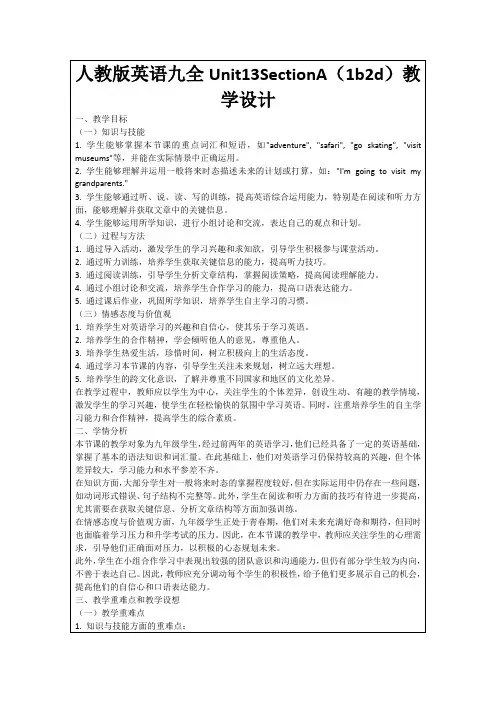
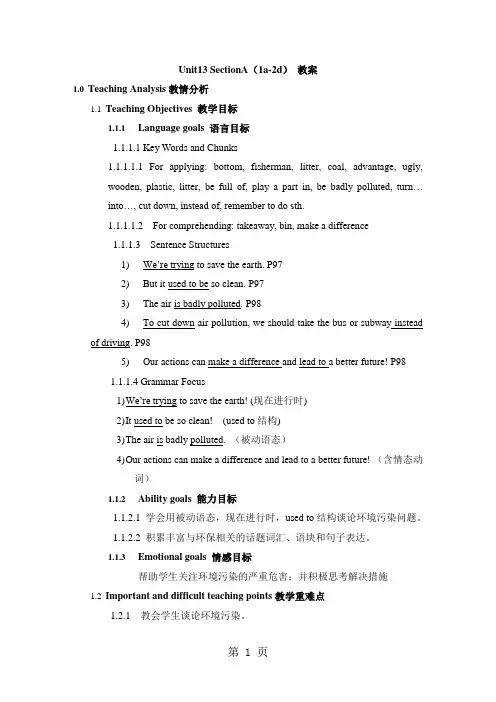
Unit13 SectionA(1a-2d)教案1.0Teaching Analysis教情分析1.1Teaching Objectives 教学目标1.1.1Language goals 语言目标1.1.1.1 Key Words and Chunks1.1.1.1.1 For applying: bottom, fisherman, litter, coal, advantage, ugly,wooden, plastic, litter, be full of, play a part in, be b adly polluted, turn…into…, cut down, instead of, remember to do sth.1.1.1.1.2 For comprehending: takeaway, bin, make a difference1.1.1.3 Sentence Structures1)We’re trying to save the earth. P972)But it used to be so clean. P973)The air is badly polluted. P984)To cut down air pollution, we should take the bus or subway insteadof driving. P985)Our actions can make a difference and lead to a better future! P981.1.1.4 Grammar Focus1)W e’re trying to save the earth! (现在进行时)2)I t used to be so clean! (used to结构)3)T he air is badly polluted. (被动语态)4)O ur actions can make a difference and lead to a better future! (含情态动词)1.1.2Ability goals 能力目标1.1.2.1 学会用被动语态,现在进行时,used to结构谈论环境污染问题。
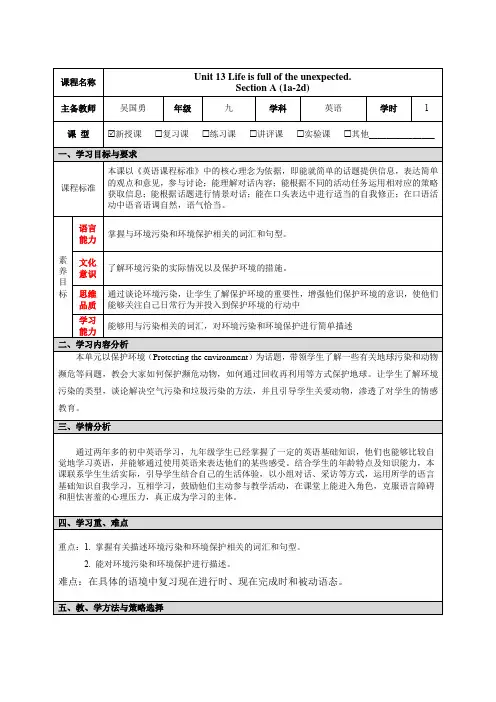
课程名称Unit 13 Life is full of the unexpected.Section A (1a-2d)主备教师吴国勇年级九学科英语学时1课型 新授课 复习课 练习课 讲评课 实验课 其他_______________一、学习目标与要求课程标准本课以《英语课程标准》中的核心理念为依据,即能就简单的话题提供信息,表达简单的观点和意见,参与讨论;能理解对话内容;能根据不同的活动任务运用相对应的策略获取信息;能根据话题进行情景对话;能在口头表达中进行适当的自我修正;在口语活动中语音语调自然,语气恰当。
素养目标语言能力掌握与环境污染和环境保护相关的词汇和句型。
文化意识了解环境污染的实际情况以及保护环境的措施。
思维品质通过谈论环境污染,让学生了解保护环境的重要性,增强他们保护环境的意识,使他们能够关注自己日常行为并投入到保护环境的行动中学习能力能够用与污染相关的词汇,对环境污染和环境保护进行简单描述二、学习内容分析本单元以保护环境(Protecting the environment)为话題,带领学生了解一些有关地球污染和动物濒危等问题,教会大家如何保护濒危动物,如何通过回收再利用等方式保护地球。
让学生了解环境污染的类型,谈论解决空气污染和垃圾污染的方法,并且引导学生关爱动物,渗透了对学生的情感教育。
三、学情分析通过两年多的初中英语学习,九年级学生已经掌握了一定的英语基础知识,他们也能够比较自觉地学习英语,并能够通过使用英语来表达他们的某些感受。
结合学生的年龄特点及知识能力,本课联系学生生活实际,引导学生结合自己的生活体验,以小组对话、采访等方式,运用所学的语言基础知识自我学习,互相学习,鼓励他们主动参与教学活动,在课堂上能进入角色,克服语言障碍和胆怯害羞的心理压力,真正成为学习的主体。
四、学习重、难点重点:1. 掌握有关描述环境污染和环境保护相关的词汇和句型。
2. 能对环境污染和环境保护进行描述。
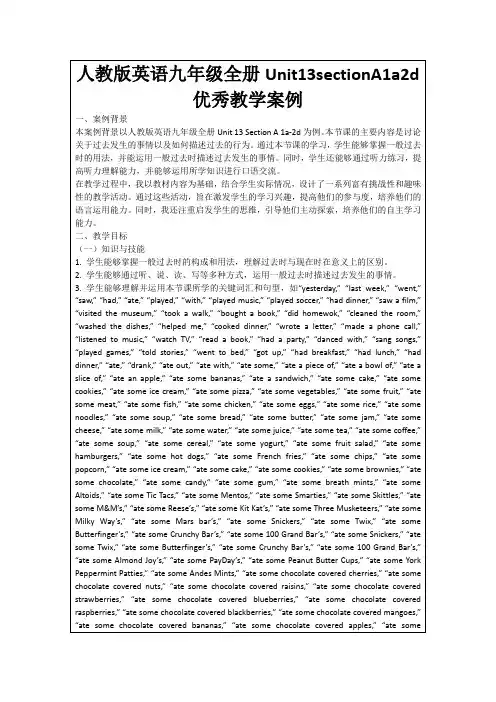
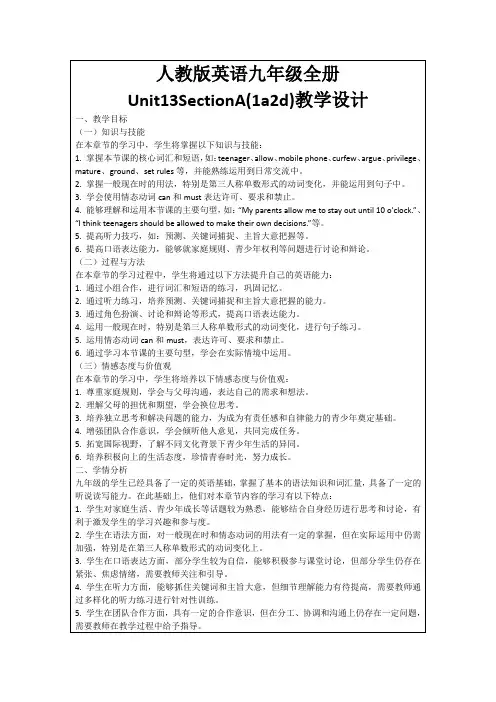
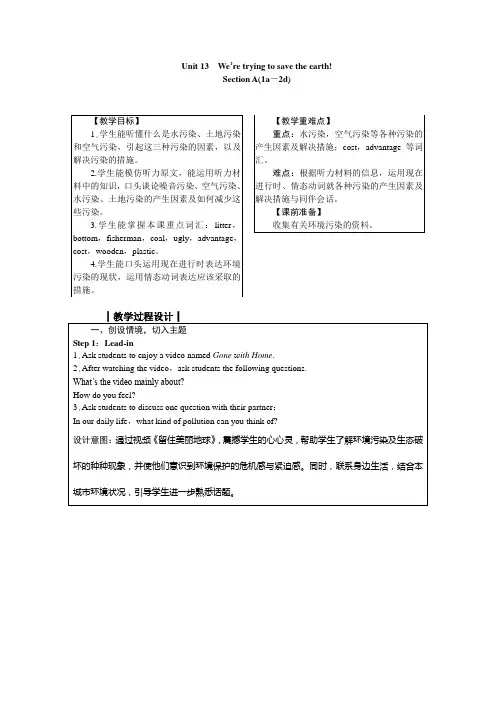
Unit 13We’re trying to save the earth!Section A(1a-2d)┃教学小结┃【板书设计】Unit 13We’re trying to save the earth!Section A(Section A(3a-4c)┃教学小结┃Section B(1a-1e)┃教学小结┃Section B(2a-2e)设计意图:读前预测,为学生在接下来的阅读中获取文章大意作准备。
思维导图可以帮助学生理清文章脉络。
Step 5:Use pictures to teach the new words.When students think about the questions in Step 3,the teacher can write down the new words on the blackboard.And teach them the new words.设计意图:适时呈现词汇,可以减轻学生的阅读压力。
While readingStep 6:Fast reading1.Ask students to look through the article quickly and find out the answer to each question.How many people are mentioned in the passage?Who are they?2.The teacher adds information to the mind-map.设计意图:扫读整篇文章,获取大意,帮助学生把握文章的整体性。
Step 7:Careful reading(Paragraph 2)1.Ask students to read Paragraph 2 carefully and fill in the chart.2.Check answers.3.The teacher adds the information to the mind-map.Step 8:Careful reading(Paragraph 3)1.Ask students to read Paragraph 3 carefully and fill in the chart.2.Check answers.Name What did she make?What materials did she use?Jessica Wong bags old clothes,especially old jeans3.The teacher adds the information to the mind-map.Step 9:Careful reading(Paragraph 4)1.Ask students to read Paragraph 4 carefully and fill in the chart.2.Check answers.Name What did he make?What materials did he use?Wang Tao beautiful art pieces iron and other materials from old cars3.The teacher adds the information to the mind-map.Which things can be done by common people every day?Which things have to be done by governments and organizations?Common people Governments Organizations2.Ask several groups to give a report.设计意图:教师让学生对所学的保护环境的措施进行归纳和分类,培养学生分析问题和解决问题的能力。
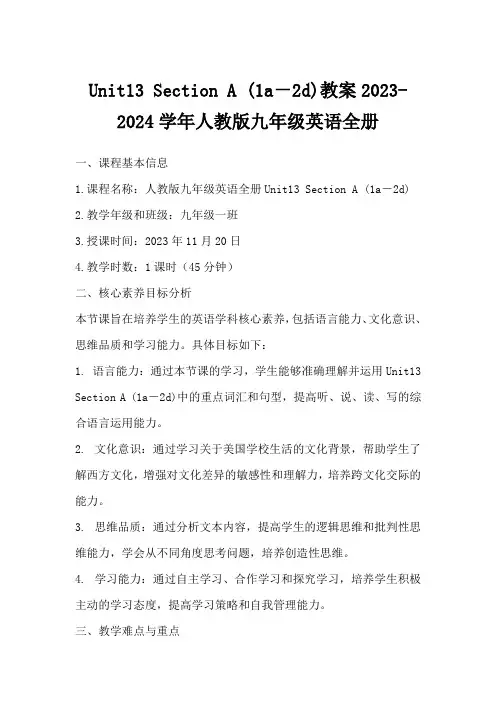
Unit13 Section A (1a-2d)教案2023-2024学年人教版九年级英语全册一、课程基本信息1.课程名称:人教版九年级英语全册Unit13 Section A (1a-2d)2.教学年级和班级:九年级一班3.授课时间:2023年11月20日4.教学时数:1课时(45分钟)二、核心素养目标分析本节课旨在培养学生的英语学科核心素养,包括语言能力、文化意识、思维品质和学习能力。
具体目标如下:1. 语言能力:通过本节课的学习,学生能够准确理解并运用Unit13 Section A (1a-2d)中的重点词汇和句型,提高听、说、读、写的综合语言运用能力。
2. 文化意识:通过学习关于美国学校生活的文化背景,帮助学生了解西方文化,增强对文化差异的敏感性和理解力,培养跨文化交际的能力。
3. 思维品质:通过分析文本内容,提高学生的逻辑思维和批判性思维能力,学会从不同角度思考问题,培养创造性思维。
4. 学习能力:通过自主学习、合作学习和探究学习,培养学生积极主动的学习态度,提高学习策略和自我管理能力。
三、教学难点与重点1. 教学重点本节课的核心内容是Unit13 Section A (1a-2d)中的重点词汇、句型和语法点。
具体包括:(1)词汇:重点掌握美国学校生活中的相关词汇,如classroom, teacher's office, school uniform, library等。
(2)句型:学会使用一般现在时描述习惯和经常发生的事情,如“I usually go to school by bus.”。
(3)语法:正确运用一般现在时的结构“主语+动词原形”,并能够辨别一般现在时和一般过去时的区别。
(4)听力理解:能够听懂并理解关于美国学校生活的对话和短文。
2. 教学难点(1)词汇:对于一些表示学校设施和活动的词汇,如cafeteria, gym, science club等,学生可能不太熟悉,需要在教学中进行解释和拓展。
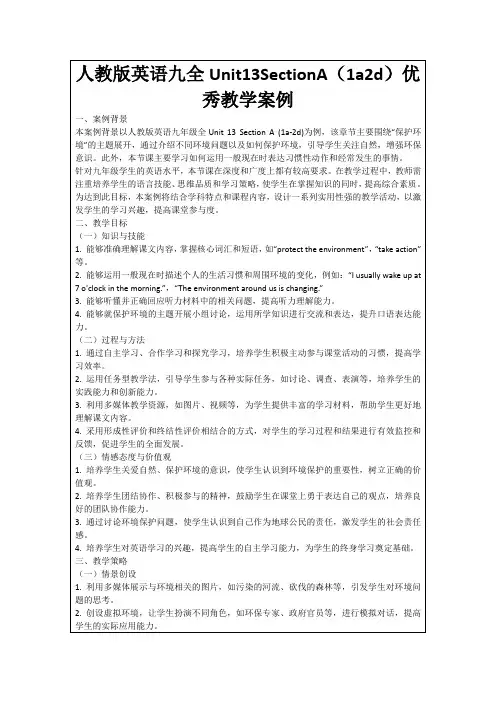
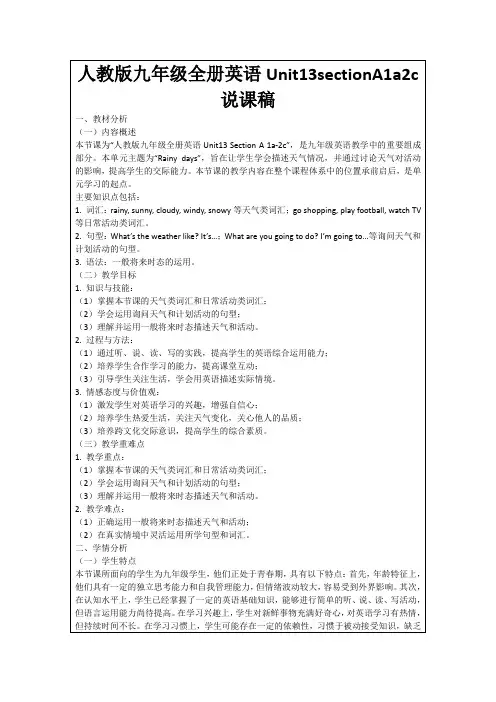
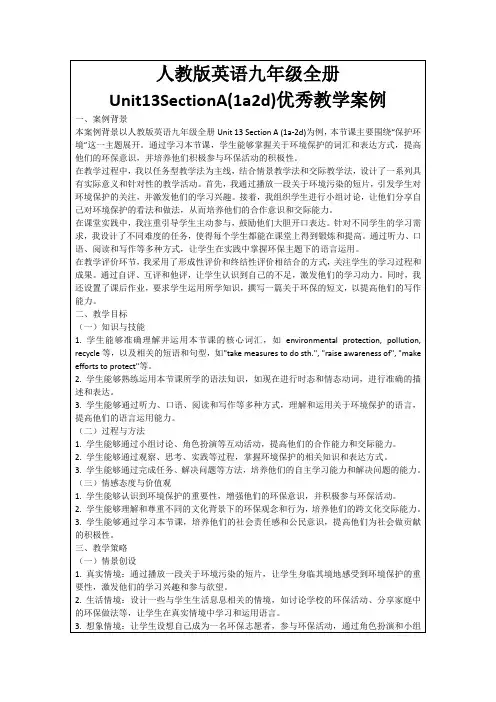
人教版英语九年级unit13 section a(1a 2d)教学设计The teaching design for Unit 13, Section A (1a 2d) of the People's Education Press English textbook for Grade 9 is a crucial component in ensuring effective language instruction and student engagement. This unit focuses on the theme of technology and its impact on our daily lives. The teaching design should aim to guide students through the key concepts, vocabulary, and language skills outlined in this section.Firstly, the lesson should begin with an introduction to the topic of technology and its role in our modern world. This can be achieved through a thought-provoking discussion or a visual presentation that highlights the ubiquity of technology in our lives. By establishing a strong foundation, students will be better equipped to engage with the content and understand the significance of the unit.The next step would be to delve into the specific learning objectives outlined in Section A (1a 2d). These objectives cover a range of skills,including reading comprehension, vocabulary development, and language structures. The teaching design should incorporate a variety of instructional strategies to address these objectives effectively.For the reading comprehension component, the teacher can begin by introducing the text and providing context to help students better understand the content. This could involve pre-reading activities, such as predicting the main ideas or discussing key vocabulary. During the reading process, the teacher should encourage students to actively engage with the text, asking questions and making connections to their own experiences.To enhance vocabulary development, the teacher can incorporate targeted activities that focus on the new words and phrases introduced in the unit. This may include word games, vocabulary puzzles, or even creative writing exercises that challenge students to use the new vocabulary in context. By providing ample opportunities for practice and reinforcement, students will be better equipped to retain and apply the new vocabulary.In terms of language structures, the teaching design should address the specific grammatical concepts and sentence patterns highlighted in the unit. This can be achieved through a combination of direct instruction, guided practice, and independent practice activities. Theteacher should ensure that students not only understand the rules but can also apply them effectively in their own writing and speaking.To further enhance the learning experience, the teaching design should incorporate a range of engaging and interactive activities. This may include group discussions, role-play scenarios, or multimedia presentations that allow students to explore the topic from different perspectives. By creating a dynamic and collaborative learning environment, the teacher can foster a deeper understanding of the content and encourage students to actively participate in the learning process.Moreover, the teaching design should incorporate opportunities for formative assessment throughout the lesson. This can involve informal checks for understanding, such as exit tickets or short quizzes, as well as more formal assessments, such as written assignments or oral presentations. By regularly assessing student progress, the teacher can identify areas of strength and weakness, and adjust the instructional strategies accordingly.Finally, the teaching design should include a summative assessment that evaluates the students' overall understanding of the unit's content and language skills. This may take the form of a comprehensive test or a project-based assessment that challenges students to apply their knowledge and skills in a real-world context.In conclusion, the teaching design for Unit 13, Section A (1a 2d) of the People's Education Press English textbook for Grade 9 should be a well-structured and comprehensive plan that addresses the key learning objectives, incorporates a variety of instructional strategies, and fosters a engaging and collaborative learning environment. By doing so, the teacher can effectively guide students through the content, develop their language skills, and prepare them for success in their future academic and personal endeavors.。
年级初三教科书版本及章节人教版九年级全一册学习领域/模块Unit 13 We’re trying to save the earth!单元教学设计单元学习主题Protecting the environment1.单元教学设计说明《义务教育英语课程标准》(2011年版)指出,语言技能是语言运用能力的重要组成部分,主要包括听、说、读、写等方面的技能以及这些技能的综合运用。
听和读是理解的技能,说和写是表达的技能。
他们在语言学习和交际中相辅相成、相互促进。
因此听、说、读、写既是学习的内容,又是学习的手段。
发展学生的语言技能就是要帮助学生通过听、说、读、写等活动理解语篇传达的信息,感受传递的情感态度,在参与不同语言活动的过程中语言能力得以提高,文化意识得以开阔,思维品质得以发展,学习能力得以提升。
英语学习活动观是指学生在主题意义引领下,通过学习理解、应用实践、迁移创新等一系列体现综合性、关联性和实践性等特点的英语学习活动,使学生基于已有的知识,依托不同类型的语篇,在分析问题和解决问题的过程中,促进自身语言知识学习、语言技能发展、文化内涵理解、多元思维发展。
本单元的主题是保护环境,属于人与自然主题语境下的环境保护主题群,涉及自然环境和人与环境内容。
本单元以期通过听、说、读、写、看等活动让学生知晓地球上存在多种污染问题、分析污染产生的原因,并表达从自身出发保护环境的意识和行动,帮助学生确立人类和环境保护之间关系的正确价值观和道德观。
初中学业水平考试改革对教学的指导:初中学业水平考试英语听说考试的题型有听后选择、听后回答、听后记录并转述和朗读短文,这些提醒在考察学生通过听来获取信息的能力之外,更是考察学生说的能力。
所以,这就要求在平时的英语课堂上要给学生练习的机会,有意识地鼓励学生多动嘴,培养其说英语的自信,尤其对语篇的转述练习,为学生参加第二次听说考试助力。
2.单元学习目标与重点难点单元学习目标1、学生知晓地球上存在多种污染问题、分析污染产生的原因,并表达从自身出发保护环境的意识和行动。
Unit13 SectionA(1a-2d)教案Teaching Analysis教情分析 1.0 Teaching Objectives 教学目标1.1Language goals 语言目标1.1.11.1.1.1 Key Words and Chunks1.1.1.1.1 For applying: bottom, fisherman, litter, coal, advantage, ugly,wooden, plastic, litter, be full of, play a part in, be badly polluted, turn…into…, cut down, instead of, remember to do sth.1.1.1.1.2 For comprehending: takeaway, bin, make a difference1.1.1.3 Sentence StructuresWe're trying1)to save the earth. P97But it used to be so clean. P97 2)The air is badly polluted. P983)To cut down air pollution, we should take the bus or subway instead4)of driving. P98Our actions can make a difference and lead to a better future! P985)1.1.1.4 Grammar Focus1)We're trying to save the earth! (现在进行时)) (used to结构2)It used to be so clean!3)The air is badly polluted. (被动语态)4)Our actions can make a difference and lead to a better future! (含情态动词)Ability goals 能力目标 1.1.21.1.2.1 学会用被动语态,现在进行时,used to结构谈论环境污染问题。
1.1.2.2 积累丰富与环保相关的话题词汇、语块和句子表达。
Emotional goals 情感目标 1.1.3页 1 第帮助学生关注环境污染的严重危害;并积极思考解决措施Important and difficult teaching points教学重难点 1.21.2.1 教会学生谈论环境污染。
引导学生思考环保措施。
1.2.2Student analysis学情分析2.0 2.1 Fundamental State基本情况本单元的教学话题是贴近生活的环保。
在语法方面,没有新的语法,学生只需运用已学的现在进行时,现在完成时,情态动词,used to结构,谈论时下流行话题--环保。
因此,可从学生所见的环境污染入手进行教学引入,分析环境污染的几种类型,环境污染的现象,再扩展到怎样解决这些问题,为后面课时逐步引入本单元的教学活动奠定基础。
2.2 Knowledge Reserve知识储备通过两年的学习和积累,学生积累了一定的词汇量,接触到了常见的话题和功能项目。
Book 7B Unit 6 I'm watching TV.和Unit 7 It's raining!学习了现在进行时,Book 8B Unit 8 Have you read Treasure Island yet?和Unit 9 Have you ever beento a museum? 学习了现在完成时,Book 9 Unit 2 I used to be afraid of the dark.学习了used to的用法,Book 9 Unit 5 What are the shirts made of?和Unit 6 When was itinvented?学习了被动语态的用法。
各种语法的学习为谈论本单元环保话题奠定了知识基础。
2.3 Class data本班实际本班学生有比较明确的学习目的,能够在小组活动中互相帮助,积极与他人合作,敢于用英语进行表达。
本课时谈论pollution, how to solve air pollution, how to solvewaste pollution,话题贴近生活,学生熟悉,有话可说,教师应该尽量创设情景,拓展思路,必要时帮助学生用英语进行准确表达。
3.0 Teaching methods教法建议3.1 situational teaching approach情景教学法3.2 question and answer method问答法3.3 discussion method 讨论法页 2 第4.0 教学辅助blackboard and chalk, computer , projector5.0 Teaching procedures 教学进程5.1 Leading-in and warming-up 引入与激趣活动Greet with Ss and ask some Ss to talk about the environment around them. 5.2 New points input 新知输入(贴标签)5.2.1 New words Look at some pictures and learn the new words.5.2.2 Language presentationPresent some pictures and ask Ss “What are these pictures about?”This activity isto elicit the topic “pollution”. Then ask Ss “How many kinds of pollution do these pictures show?”Elicit Ss to three kinds of pollution: noise, air and water pollution 5.2.3 Activity 1a5.2.3.1Get Ss to write the words related to different kinds of pollution in the box.5.2.2.2Group work. Get Ss to work in groups and talk about some more noise pollution, air pollution and water pollution.5.3 Listening practice 听力训练5.3.1 Activity 1b5.3.1.1 Pre-listening.Ask Ss about their opinions about pollution. Introduce Tony and Mark to them. Then ask them to look through the chart in 1b on page 97. T plays the recording for the first time.5.3.1.2 While-listening.Check the answers: really dirty, rubbish, fish, litter, waste, government, close down, clean up.页 3 第5.3.1.3 Post-listening.Play the recording and get Ss to read after recording.Activity 2a, 2b5.3.22a and 2b provides listening practice using the target language.5.3.2.1 Pre-listening.T introduce Jason and Susan to Ss. Ask Ss to listen to the interview and circle the kindsof pollution.5.3.2.2 While-listening.T can give Ss the opportunities to show their answers.The answers to 2a: a, bThe answers to 2b: 1. more cars 2. pollute 3. are throwing away 4. publicplacesIf Ss give some incorrect answers, T can play the recording again.5.3.2.3 Post-listening.As a post-listening task, T can get Ss to have a discussion within 1 mint. For example ,Have you ever seen these environmental around you? What other problems do you see?What do you think has caused these?口语输出5.4 Oral OutputActivity 2d talks about solutions to environmental problems.5.4.1 T can guide Ss to understand the whole conversation. T can play the recording for Ss to listen and repeat. Read the conversation in roles.5.4.2 T can encourage Ss to read the conversation alone and fill in the blanks. Pollution Solutionair pollution1. ____________________________2.____________________________1. ____________________________waste pollution 2.____________________________3. ____________________________页 4 第4.____________________________5.4.3 Get Ss to share their answers and check the answers together.5.4.3 Ask Ss to practice several times and ask pairs to come to the front and act outtheir own conversations or role-play the conversation only. Sentence Interpretation 难句理解5.5 5.5.1To cut down air pollution, we should take the bus or subway instead of driving.。